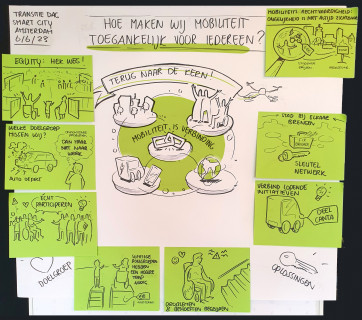While our mobility system and its options are continuously expanding, there’s a growing number of people who feel excluded from the mobility system and experience a lack of access to services like public transport and shared mobility options. The concept of Mobility Poverty shows there are a variety of reasons for this exclusion, ranging from economic and geographical reasons, to falling behind on digital skills. If we want to move towards ‘Mobility Justice’, we would need a detailed image of the groups experiencing this exclusion and we would need a variety of actors to come up with -and implement- creative solutions to this emerging problem.
For the past months, Chris de Veer and I have been busy setting up a regional coalition and program on this subject. Because it’s becoming clear we’re discussing a problem we, a pool of mobility specialists, are not experiencing ourselves, we decided to critically look at what parties have a seat at the table. During the Amsterdam Smart City Transition Day on June 6th, we gathered input and reflections on the power structures in play and considerations when involving your target group in decision making.
Understanding power relations and structures when working on transitions
When designing solutions and innovative policies, it’s important to understand and be aware of the power structures in play. Our partner Kennisland is concerned with the topic and introduced this discussion within our network during on of our ‘Kennissessies’ earlier this year. Together with this session’s participants, we used their method to evaluate which parties have been involved in the initial phase of our Mobility Justice challenge.
It became clear that it had been mostly governmental parties which were involved in exploring the topic and initiating the design of a cooperation program. While this is of importance for practical matters like funding and political support, the group should have been diversified when we started exploring the problem and its solutions. The (target) group we’re talking about is currently lacking the power to help design both the collaboration process itself and the initiatives that should help fight Mobility Poverty.
Considerations when engaging with your target group
There was a general consensus in the group that we should now make more of an effort to engage with our target group. But how exactly? The group discussed different existing forms of involving a target group in decision making and advised us on matters to consider, namely;
- Decide in what stage(s) of the process collaboration or input is needed. Exploring the problem will require a completely different conversation and method compared to the stage of co-designing solutions.
- Be very clear about what you’ll use the outcomes for. If you decide to gather input from - and collaborate with your target group, you’ll need to actually incorporate the outcomes within your process. This is necessary to maintain the groups trust and validate their efforts.
- Besides defining problems and exploring its solutions, evaluation of the initiatives that follow will be equally important. Special efforts need to be put into place to keep the dialogue going with the target group during and after testing initiatives.
Next steps: Harnessing the power of community centres
When discussing potential next steps for the group, one of the session’s participants reminded us of the power of community centres. She mentioned an example in her own neighbourhood, where a group of neighbours initiated a sharing vehicle for elderly/disabled people. This example illustrated how local communities know best what specific problems or needs are at play, and how to set up solutions in a quick manner.
This conversation inspired us to now look for relevant local initiatives and community centres in the Amsterdam region. With their help, we hope to better understand problems related to Mobility Poverty and what specific solutions people need within their local context.
A call to the community
I’m now wondering if there is anyone in our Amsterdam Smart City community who could link us to local initiatives and community centres in the Amsterdam region? Mobility-related topics are a plus, but this is certainly not necessarily. Any advice or tips to share? Send me an email at pelle@amsterdamsmartcity.com. This summer, we’ll design the continuation of this project.





